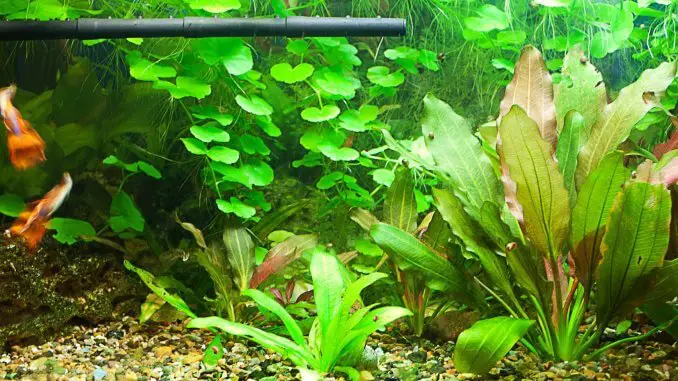
With their bladelike appearance and impressive endurance, the Amazon Sword Plant has earned a spot among the most popular aquatic plants.
This plant is beautiful and easy to care for, and will create a forest-like effect in your tank – it’s great for beginners and experienced aquarists alike!
What’s even better is its ability to reproduce in the tank, giving you a chance to share this wonder with friends or diversify your other tanks.
TABLE OF CONTENTS
About The Amazon Sword Plant
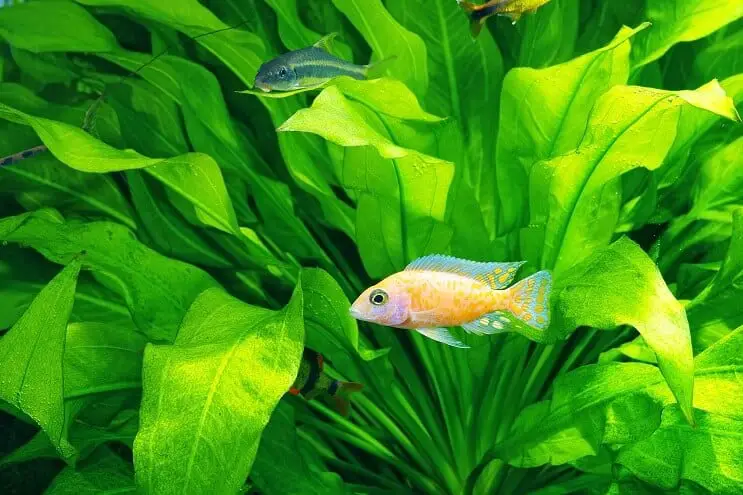
| Category | Rating |
| Family: | Alismataceae |
| Care Level: | Easy |
| Growth Rate: | Moderate |
| Maximum Size: | 16 Inches |
| Minimum Tank Size: | 10 gallons |
| Water Conditions: | 60.8-82.4°F; 6.5-7.5 pH; 8-15°dH |
| Lighting: | Mild to moderate |
| Propagation: | Vegetative; runners |
| Placement: | Mid-ground |
The Amazon Sword Plant (Echinodorus grisebachii/amazonicus) is an aquatic plant that has become very popular with fish keepers worldwide over the past several years.
It originates from the extremely diverse and beautiful Amazon River basin.
Although the whole Echinodorus genus is known as Amazon Sword Plant, many aquarists refer to the Echinodorus grisebachii or Echinodorus amazonicus as the true Amazon Sword Plant – they are the same plant.
Even though you will find lots of plants being sold as the Amazon Sword Plant, this isn’t a problem because they more or less all require the same tank conditions and have the same care needs.
Other Echinodorus plants can also be found in the USA, Cuba and Columbia. However, most of the plants grow in the region of the Amazon River, an area with unique flora and fauna.
It is commonly found in aquariums all over the world mainly due to its sturdiness and ability to tolerate a wide range of temperatures. These plants are not only a great choice for fish tanks but are quite popular in plant-only aquariums as well.
This plant is not particularly expensive. Most will be in the range of $5–7 per plant. Price will always depend on the size of the size, with some retailers offering an “extra-large” plant from $10.
Appearance
Plants in this genus all have a very similar appearance and are easily mistaken for one another, especially because so many of them are used in aquariums.
This is a bushy plant with a short stem. All the leaves extend straight from the roots on thin scapes. The leaves themselves make up most of the plant’s length and reach nearly 14 inches. This plant is quite a large one, growing up to 15-16 inches.
They get their name from the uniquely-shaped leaves that resemble sword blades. Leaves start to widen out near the base, reaching maximum thickness near the middle and narrowing down again towards the top of the leaf.
In good water conditions, you should expect your plant to be a slightly dark green color. If at any point it starts turning a brownish or muddy red color, it’s an indicator of lack of nutrients.
The roots of this plant are important to mention. Its rootstock (rhizome) is pretty large and powerful. Due to this, it can penetrate the substrate quite far down. They are light in color and spread out widely and deeply into the substrate.
How To Plant Amazon Swords
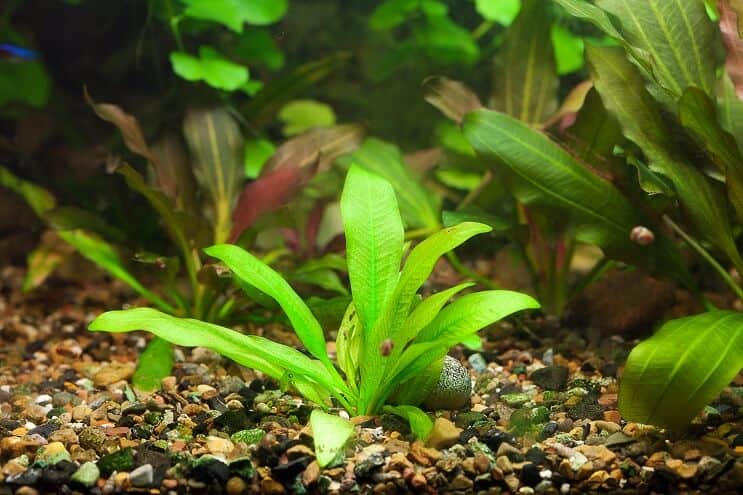
Before you can plant your Amazon Sword you need to make sure you have a healthy specimen.
When it comes to choosing and buying your plant, keep in mind the basics. For example:
- Does the color of the plant seem healthy to you?
- Do the leaves look strong or are they dying?
- Is the tank it’s being kept in clean?
- Are there any fish with the plants?
By asking yourself these questions, you will save time and money as well as get yourself a good-looking and healthy plant.
What you want is a nice light or dark shade of green. Leaves should have precise and accurate edges without any apparent scratches, or worse, cuts. You will instantly be able to tell a good plant from a bad one.
Once you’ve purchased a healthy specimen, you can start planting it.
You probably noticed how many times we’ve mentioned the importance of the substrate. That’s because of the powerful rootstock this plant has. It needs a solid base in order to successfully grow.
Which substrate you choose is not as important as its actual thickness. The substrate should be around 2.5 inches thick.
The Amazon Sword Plant should be placed in the center of the tank. This will provide enough space for it to grow and reach its maximum height. As the plant is quite bushy, it will be a great hiding spot for many aquarium inhabitants.
Planting it is simple. Firmly place it into a hole in the substrate leaving the crown of the roots visible.
Although you are free to choose any type of substrate, we recommend using large-grained sand.
Caring for Amazon Sword Plants
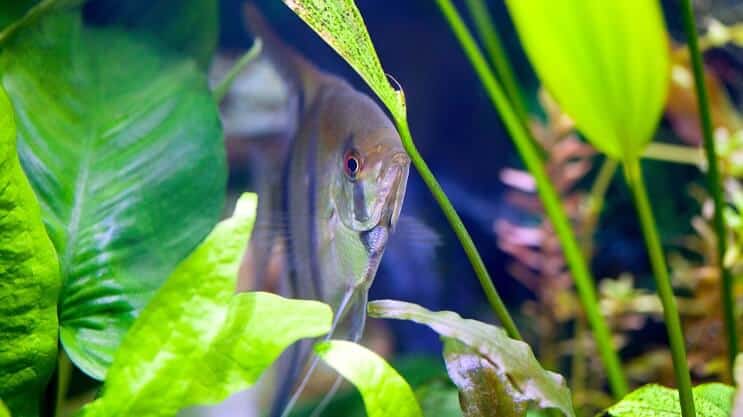
Tank Requirements
This plant comes from an extremely diverse biological region of the Amazon River basin – a very green, humid, and warm place. Its tropical habitat provides a very good nutrient-rich substrate for growth.
The natural weather conditions that it’s used to are very varied, which makes this plant tolerant and enduring. Another thing it’s loved for.
All this combined makes it a perfect starting choice. Replicating its natural habitat isn’t difficult.
First of all, you need to keep in mind that the tank should be tall enough not to limit its growth. Your tank should be at least 16 inches high to ensure this doesn’t happen.
It can tolerate a wide temperature range. However, it’s better if you keep it within narrow limits. The optimal temperature range would be 68-75°F.
Water acidity should be neutral, pH around 7. Small deviations can happen but try keeping them to a minimum pH of 6.5-7.5. If the temperature is kept within acceptable limits, water hardness shouldn’t be a concern: 8-12°dGH would be just right.
Substrate is one of the most important things when it comes to Amazon Sword Plants (as mentioned in the planting section above) – make sure it’s at least 2.5 inches thick.
Maintenance
Thankfully, these plants don’t need a lot of care or attention.
Trimming this plant is not necessary. Making sure that it has enough space for growth is much more important. During propagation, you can cut off unwanted shoots. The same goes for when it starts expanding in the tank, or when leaves become larger than you want them to.
Unfortunately, sometimes your plant may catch an infection or just become ill. The leaves of your plant start losing shape and their color begins to deteriorate. So, you end up with a blackish outgrowth.
If you notice this happening at an early stage, try removing the sick leaves and checking the quality of the water – make sure they match the requirements mentioned above.
Lighting is another important thing for health. You can use any sort of lamp, either a luminescent or a simple filament one. Lighting should be on for around 11-12 hours a day.
Let’s talk a bit about supplements now.
First, bear in mind that this plant can successfully flourish without any additives.
A good aeration system can have a positive effect on its growth rates. As we mentioned before, this plant can tolerate a wide range of water parameters. However, if the water is too soft, the plant may show signs of mineral starvation.
To get rid of the symptoms add combined supplements containing micro-elements to the tank. Around 0.05 oz. per 25 gallons once a week should be enough.
Besides everything we’ve covered so far, there is one very important thing we haven’t touched upon yet: frequent water renewals. There are many conditions this plant may develop in, but dirty water is not one of them.
The Amazon Sword Plant requires weekly renewals of about 20% – this is key to keeping it strong and beautiful.
If you follow all our advice, then you can expect your plant to grow evenly throughout the year. Please always keep in mind their size and choose the volume of the tank accordingly.
Care Tips
- Adding supplements specifically for this plant is not really necessary. This plant gets most of the nutrients together with fish foods and fresh water.
- The Amazon Sword Plant will help you keep the water clean and get rid of the unwanted compounds.
- Unfortunately, Amazon Sword Plant is prone to algae growth. It will get even worse if you don’t follow the lighting regime. By leaving light switched on for longer, you facilitate algal growth. Algae can quickly turn your aquarium into a real mess.
How To Propagate An Amazon Sword Plant
Propagation of this plant is fairly straight forward.
These plants develop a long maternal stem, on which plantlets start to appear. After some time, these small plantlets will develop their own root system and a couple of leaves.
When you see that both (roots and leaves) have developed, plantlets can be cut off and placed elsewhere in the tank. Placing them in other tanks is also an option but make sure that the substrates are similar – small shoots can struggle to adapt to a completely new environment.
Under good aquarium conditions, this will happen naturally.
It’s important to keep the plantlets that you cut off submersed; this will help them grow faster and ensure that they develop properly.
You can place developed plantlets into the substrate and secure them with small rocks. During early stages, increased CO2 and a few supplementary nutrient portions are beneficial for their health and growth.
Be careful not to cut off an underdeveloped young plant. Don’t panic if you find that small plantlets appear slightly yellowish, it is quite common for young Sword plants.
Amazon Sword Tank Mates and Compatibility
It is compatible with other plants from the same genus (Echinodorus) as well as with some species from the Alismataceae family.
A great plant to consider is the spade-leaf sword plant (Echinodorus cordifolius).
In its natural environment, this plant is found alongside a huge variety of animals. It can be placed into almost every communal tropical freshwater tank.
Some fish you might consider keeping in the same tank are tetras or other cichlids. Additionally, characids or any other fish from the Characiformes order will be a good choice.
A few other popular choices include:
The only concern with adding fish is that they will eat your plant. If you really don’t want to see your plant being bitten, we would recommend getting either bottom dwellers (like Plecos) or small cleaners that would feed on algae instead of the plant.
Avoid keeping any fish that are overly rough and likely to uproot your plant. Some Goldfish, depending on their size and temperament are not an ideal match.
Are Amazon Sword Suitable For Your Aquarium? (Summary)
This plant is a sturdy one and doesn’t require lots of attention. That makes it an ideal choice for beginner aquarists. Experienced tank keepers, however, will also enjoy seeing this beautiful plant prosper in their aquarium.
The most important aspect of looking after this plant is frequent water cycles. Dirty and polluted water will result in your plant getting sick and dying. Acidity should also be closely watched.
Overall, the Amazon Sword Plant is a great choice that would fit into almost any tank set up with plenty of different species of fish – it will look stunning in the background.
In addition, it will provide a solid starting point for anyone wanting to get to grips with aquarium greenery.
What plants do you keep in your tank? Let us know in the comments section below…

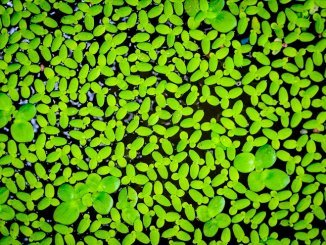
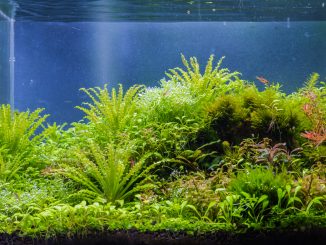
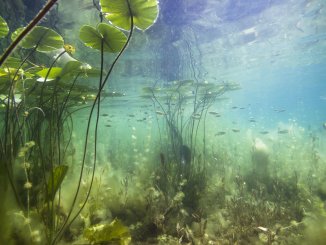
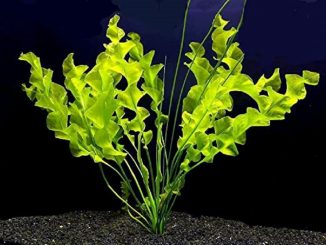
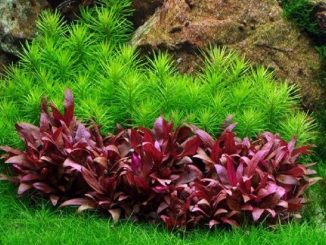
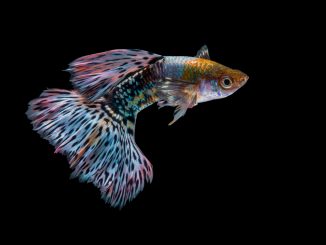
I love discus and would love to have a planted tank, but i am not a fan of snails, hence my hesitation, i am in the process of transfering from a 120 to a 200 gal, tank with the hope of focusing on about 10 discus, i am at present using plastic plants, but want to change, Amazon Sword is my main plant of interest if i can get a snail free specie what would be your advice for my venture.
Hi Homer, there aren’t many plants that are guaranteed to be free from snails unless you buy lab grown plants. Amazon Swords are a great choice for Discus. Thanks, Robert
Snails can be beneficial to your tank, I’d managed properly. That add no biology, and are prolific algae scrubbers
I have discus in a 80gal planted (incudes swords almost 20″ tall) taking. The taking includes cichlids,gouramis,barbs, plectos, redtailed shark (boy did this sucker grow!), siamese algae eater. Everything and everyone is content and happy.
Very informative article. I loved every word n already have bleheris that are doing well. Things are easier to understand when you already have some experience with them I think.
Seems like I’m doing the right things and what the article says is deff on spot. Thank you for posting it.
I have 40 gallons Aquarium and I bought a bIG Amazon Sword that looks amazing but it is take IMG almost half of my tank ! I have 2 angel fish and 2 discus fish in my tank .
How do I trim the plant smaller ? I wanna give more space for them to swim …
What should I do if all the leaves are turning yellowish/light brown and thinning to see through? Just started some shrimp florin multi liquid ferts, and some flourish excel? Good idea, bad idea? Recently transplanted from a 65 that leaked to a 125 that had cycled maybe a month or two?
Hoping I can save they are big and beautiful
Thanks in advance.
I don’t have the answer, but I do know that this is a common problem with Amazon swords because I see this exact question dropped frequently in the midst of planted tank forums….and everyone skips right over it. I know this because I’ve been looking. I’ve got the same problem.
I had the problem of transparency (skeletal effect) on my swords, for years. It dawned on me, recently, the following conditions worked for me:
1) iron and calcium carbonate remain concentrated on the gravel, no matter how much “flow” exists with a filter. When changing the water, I’ve been vacuuming the gravel. This prevents accumulation of the minerals which harden the water, including (but not limited to) iron, copper, calcium carbonate, etc.. Fish poop contains “unused” iron, calcium carbonate, etc. which also settles on the gravel. This will harden the water also. Food each day increases the hardness through the months and years. Even bottom feeders poop out minerals. Vac the gravel each time you do a water change. After a few months, vac every other time. Use only distilled water, for a couple months to replace the removed water. Do not use iron or calcium carbonate supplements for 6 months.
2) Do not use carbon in your filter or anywhere. Carbon removes iron; this may account for the skeletal effect.
3) Patience…. Changes will not be immediate.
4) Do not use pH adjustment agents; the swords are flexible/tolerant. pH will eventually set itself!
5) Don’t overfeed. This may cause ammonia buildup, which will harm both plants and fish, causing skeletal effects on the plants, and fin rot on the fish.
6) Lighting should be minimal required, based on the fussiest plant in your tank. Do not keep your tank in front of a window, as the sunlight will bring more algea to your tank. Use the best light spectrum you can find. The flourescents tend to add more blue, and the incandescents add more red. There are LED light fixtures on the market, which you can adjust one of the spectral colors…adding more or less of that color. They’re very expensive, but worth every penny.
I have a large Amazon Sword Plant how can I get starts from this plant ?